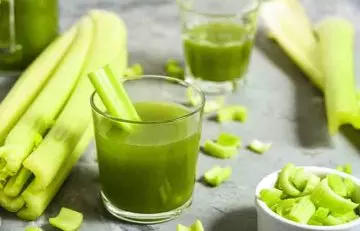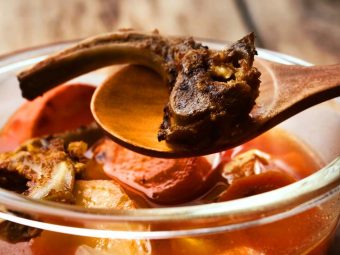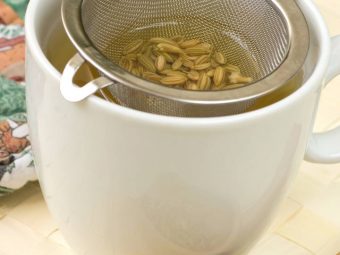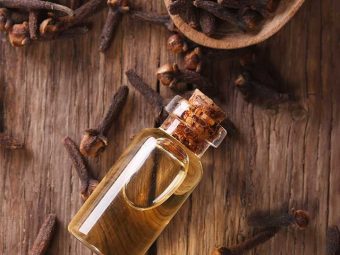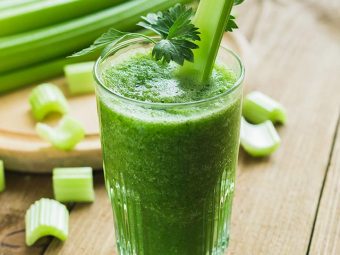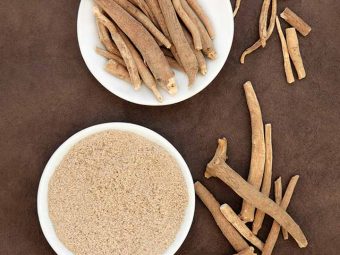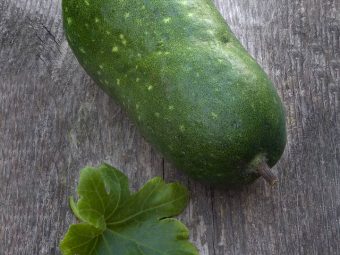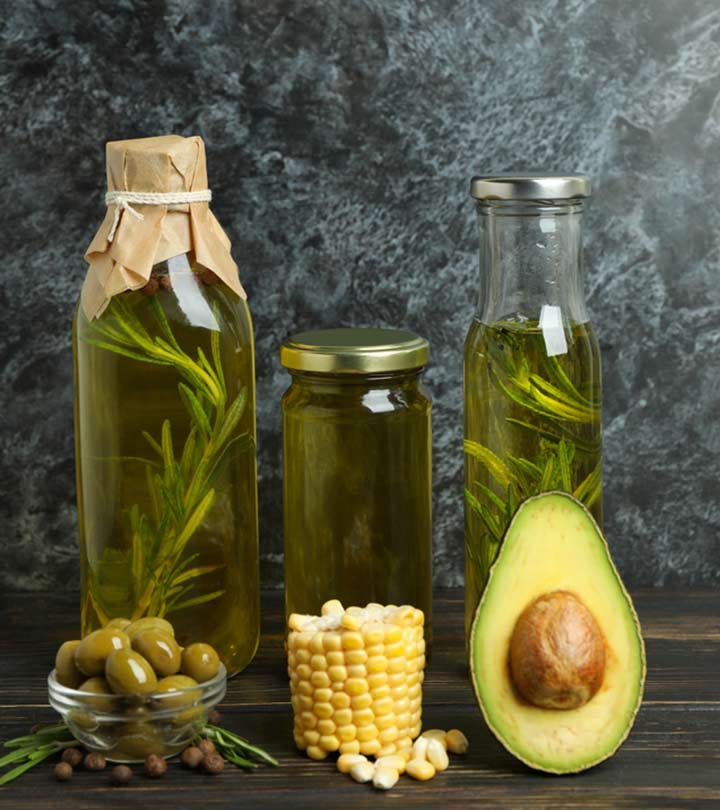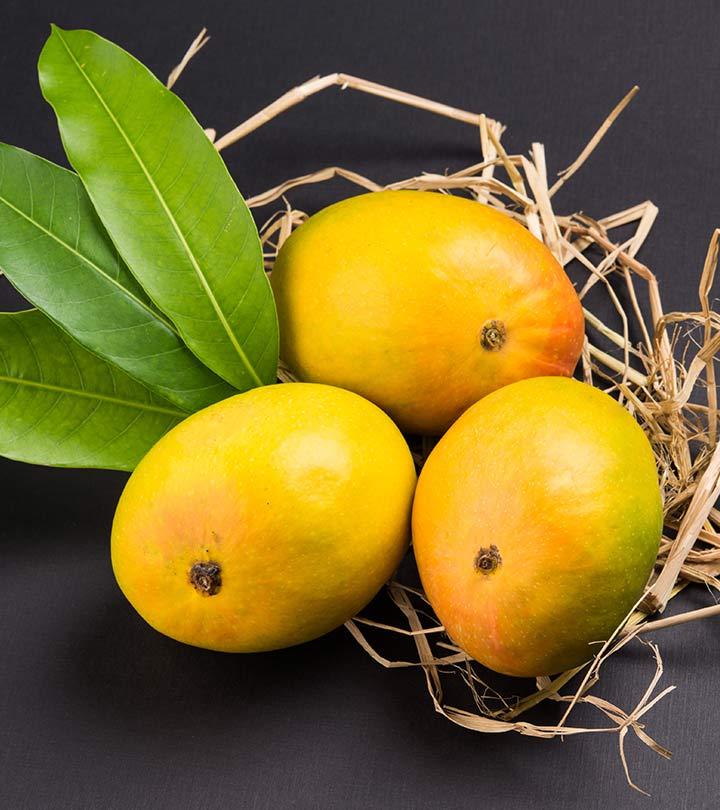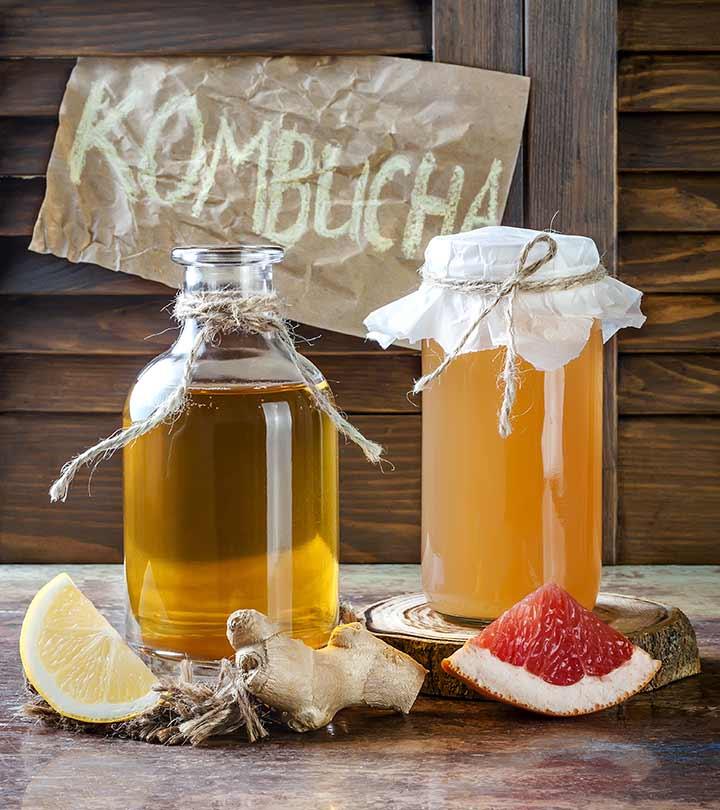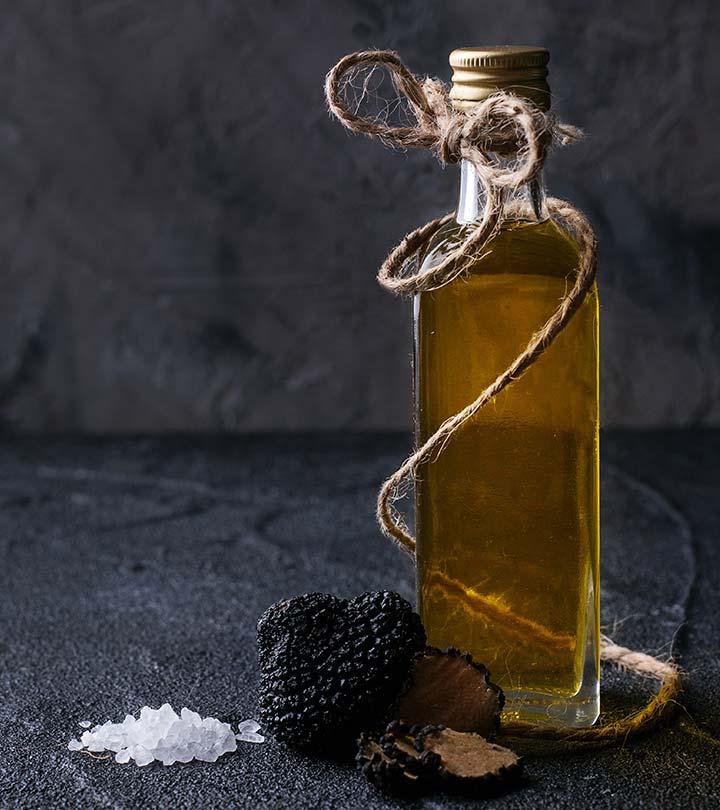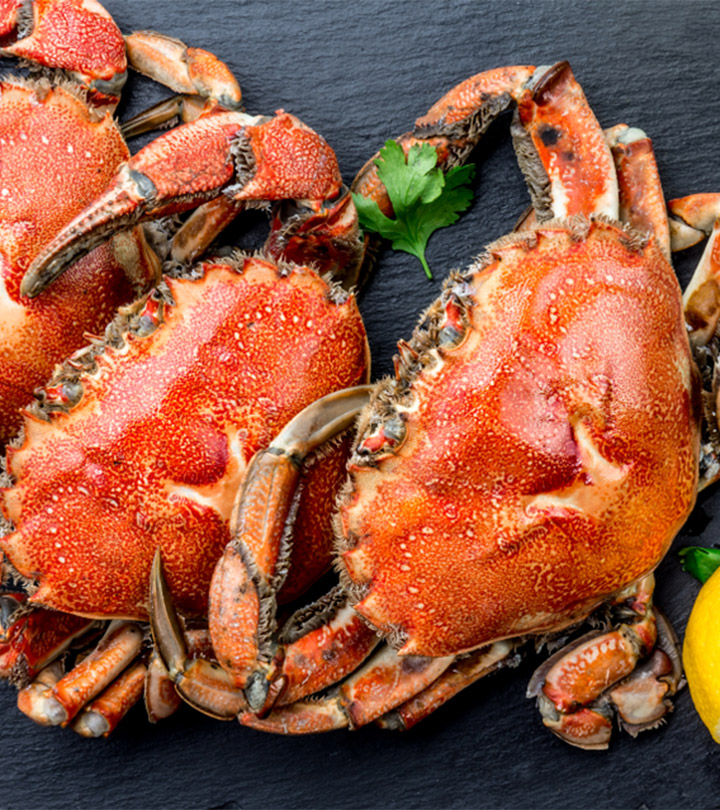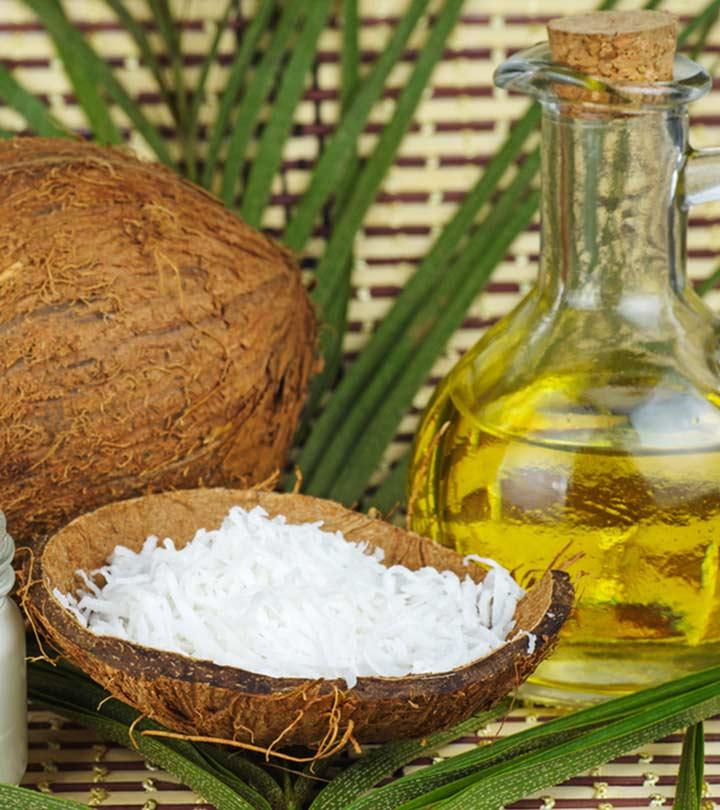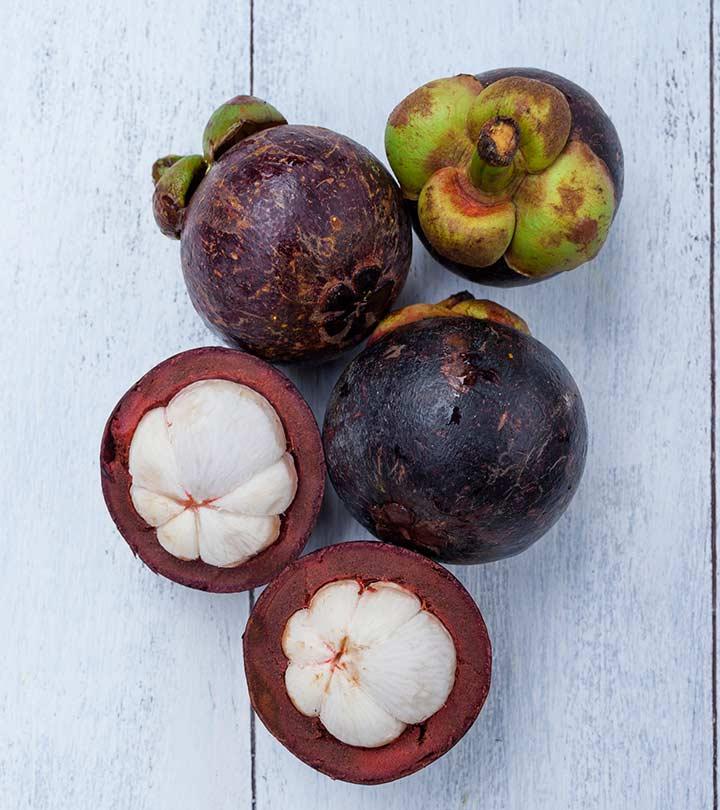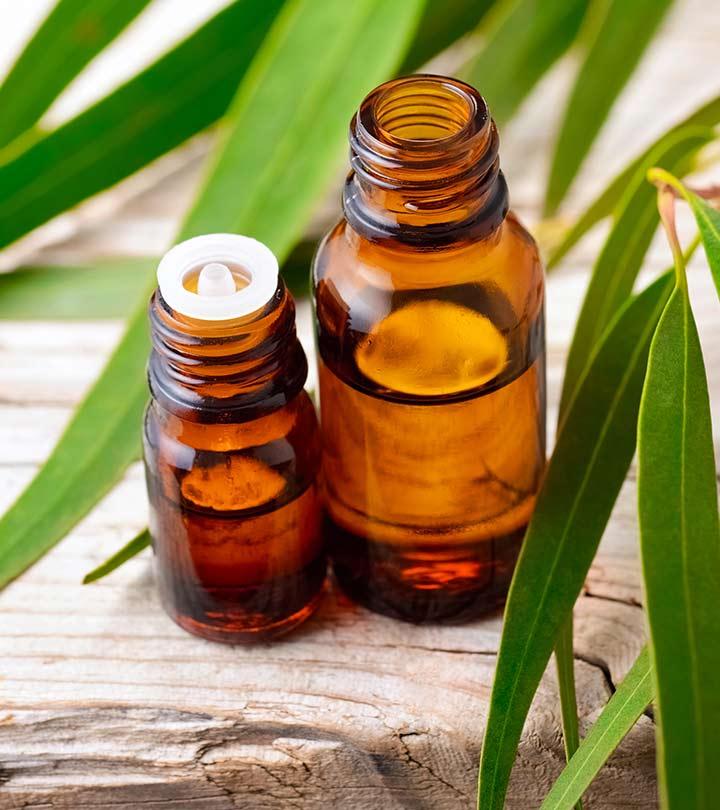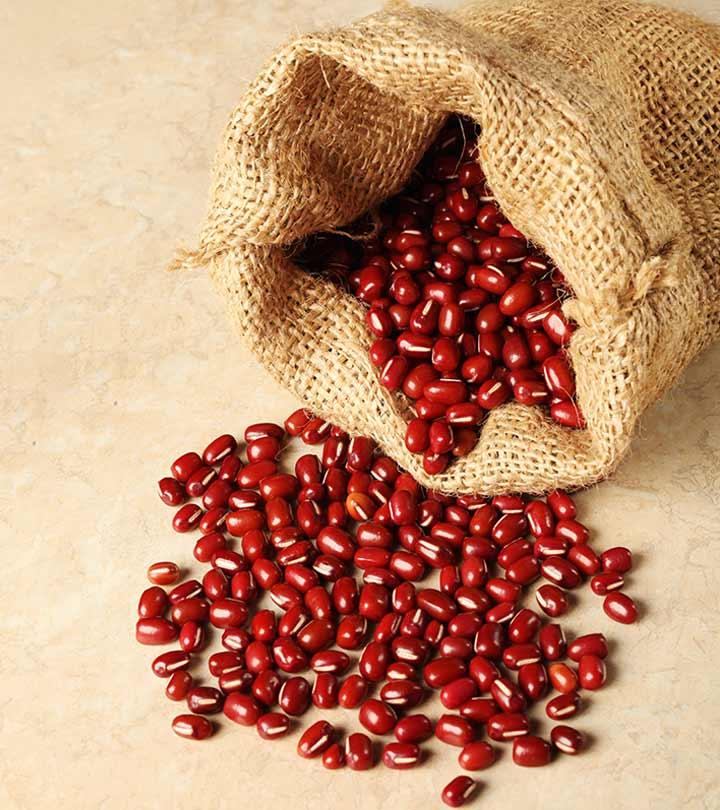16 Celery Benefits, How To Consume It, And Side Effects
Include this low-calorie vegetable in your diet to improve your overall health.

Image: shutter stock
The health benefits of celery may entice you to consume more of it. Celery (Apium graveolens) has high water content and low calories. Numerous health benefits are associated with this green veggie. Celery contains antioxidant properties, vitamins, minerals, and phytonutrients and plays a critical role in managing many health issues. It may help reduce cancer risk, and inflammation, promote heart health, and boost digestion. This article discusses the benefits of celery, its nutrition profile, how to use it, and any potential side effects. Take a look.
 Know Your Ingredient: Celery
Know Your Ingredient: CeleryWhat Is It?
It is a green, leafy vegetable often used in salads, soups, and other dishes.
What Are Its Benefits?
It is low in calories and high in nutrients, including vitamin K, vitamin C, and potassium.It also has anti-oxidant and anti-inflammatory properties.
Who Can Use It?
Anyone can include celery in their diet.
How Often?
It is recommended to have 1 to 4 stalks every day.
Caution
Individuals with kidney problems or taking blood thinners should consult their doctor before consuming large amounts of celery.
In This Article
What Are The Benefits Of Celery?
Celery is a low-calorie vegetable known for its high water content. It is a rich source of dietary fiber that helps promote digestive health. It contains flavonoids that protect the body against free radical damage. Celery contains essential nutrients like potassium and calcium that support a healthy heart. In addition, folate and vitamin K in it promotes red blood cell formation and efficient blood clotting.
Devon Cassidy, RN, MSN, RWP, says, “Celery is so much more than just a water-dense, low-calorie vegetable and is anything but bland! A single celery stalk is jam-packed with vitamins and antioxidants like vitamin C, beta-carotene, flavonoids, and other phytonutrients aka plant compounds that have profound anti-inflammatory effects that protect from oxidative damage. In fact, celery and its seeds contain over 25 anti-inflammatory compounds that can reduce proinflammatory cytokines and prevent inflammation throughout the body.”
Yelena Wheeler, MPH, RDN, adds, “Celery is a fibrous food that assists with digestion and satiety while also being very low in carbohydrates. It can assist with reducing fat as part of a balanced diet. Celery is known to help the female body to keep the bladder healthy, which can prevent urinary tract infections.”
 Trivia
TriviaIf you do not know what is celery good for, here are some of the major health benefits of having celery:
1. May Help Reduce Cancer Risk
Celery is rich in antioxidants that aid cancer prevention by fighting against cancer-promoting free radicals. It contains two bioactive flavonoids – apigenin and luteolin – that may kill cancer cells in the body (1). Apigenin is a chemopreventive agent, and its anti-carcinogenic properties destroy free radicals in the body to promote cancer cell death. It also promotes autophagy, a process through which the body removes dysfunctional cells that helps prevent disease (2).
The anticancer property of luteolin inhibits the cell proliferation process (3).
These flavonoids in celery have the potential to treat pancreatic and breast cancers (4), (5).
Celery is also said to possess bioactive polyacetylenes. These chemo-protective compounds have the potential to prevent numerous cancer formations (6).
Caspase is a rich protein that may help kill breast cancer cells. The graph below shows the caspase activity of different human melanoma cells after their interaction with parsley, chamomile, and celery extracts.
Antimicrobial Potential Of Chamomile, Parsley, And Celery
Source: Botanical Therapeutics (Part II): Antimicrobial and In Vitro Anticancer Activity against MCF7 Human Breast Cancer Cells of Chamomile, Parsley and Celery Alcoholic Extractss2. May Lower Inflammation
Celery is replete with phytonutrient antioxidants that possess anti-inflammatory properties. A study conducted by Harbin Medical University (China) found that this vegetable is also an important source of flavonols (7). Another study conducted by Ohio State University found that celery juice or celery extracts also reduce the activity of certain proteins that are linked to inflammation (8). Celery seed extracts are said to possess anti-inflammatory properties (9).
Celery also contains a compound called luteolin that can prevent inflammation in the brain cells (10). A study conducted by King Saud University (Riyadh) on rats suggested that celery can inhibit the growth of Helicobacter pylori, a bacteria that causes gastritis (inflammation of the stomach lining) (11).
3. May Lower Blood Pressure Levels
Celery has been found to contain a phytochemical called phthalides, which relaxes the artery walls and increases blood flow. It also expands the smooth muscles in the blood vessels and helps lower blood pressure (12). An Iranian study conducted on rats attributed the antihypertensive properties of celery to the same phytochemical (13). Celery is also rich in nitrates that may help lower blood pressure (14). Other reviews of the phytochemical profile of celery seed extracts also indicate that it may lower blood pressure levels (15).
In traditional Chinese medicine, celery was often termed as a “cool” cooking ingredient that could lower blood pressure (16). Another study found that fresh celery juice mixed with vinegar is given to pregnant women in South Africa to lower their high blood pressure (17).
4. May Improve Cardiovascular Health
Celery is usually administered as an anti-hypertensive agenti XDrugs that assist in treating high blood pressure by removing salt and fluid from the body. in traditional medicine. It could help maintain cardiovascular health. A study conducted in Iran found that celery leaf extract can improve numerous cardiovascular parameters like cholesterol, triglycerides, and LDL (bad cholesterol) (18).
Celery is high in polyphenols that have anti-inflammatory and cardiovascular benefits (19). However, more research is required to understand this benefit of celery in humans.
5. May Promote Neurogenesis And Prevent Memory Loss
Celery may reduce the risk of memory loss. A study conducted at the JiNan University (China) found that there is a link between luteolin (a flavonoid found in celery) and lower rates of age-related memory loss. Luteolin calms brain inflammation and may help in the treatment of neuroinflammatory disordersi XDisorders that occur when the immune system becomes overactive and tends to attack the healthy cells in the brain, spine, and eyes. (20). Thus, it may also help reduce the risk of neurodegenerationi XThe progressive loss of function in the nerve cells that affects one’s ability to move, talk, etc. .
Apigenin, a bioactive flavonoid found in celery, is believed to aid in neurogenesis (growth and development of nerve cells). However, this factor is yet to be proven in humans. Apigenin may also contribute to the health of neurons. However, research is unclear in this regard (21).
6. May Aid Digestion
Again, research is limited in this regard. However, anecdotal evidence suggests that celery may promote digestive health. The natural fiber found in celery makes it an important food for the digestive system. The soluble fiber in celery is fermented by the bacteria in the large intestine. This fermentation process produces short-chain fatty acids, one of which (butyrate) promotes gastrointestinal health. Celery also contains insoluble fiber and may promote bowel movement.
Jasmin, a lifestyle blogger, shared her experience of drinking celery juice for 60 days to help manage her IBS (Irritable Bowel Syndrome). She said, “IBS may not have a tangible cure yet, but drinking my juice daily has been the closest I’ve ever been to a healed and healthy gut (i).”
7. May Improve Sex Life
Celery contains androstenone and androstenol, male hormones that are believed to stimulate sexual arousal in women. They have the potential to boost arousal by emitting scents that can make you more desirable (22).
A study conducted on male rats found that celery extracts enhance sexual performance (23). The dosage was found to increase sperm count in rats. It can even increase the secretion of testosterone (24). However, more research is required to verify this effect of celery in humans.
8. May Aid Weight Loss
Celery is low in calories and contains fiber that makes you feel full for longer periods. The insoluble fiber content of celery can increase satiety and aid weight loss. Celery’s high water content may also aid weight loss. It also regulates lipid metabolism (25).
It can also be consumed with other vegetables that have a higher energy density. Anecdotal evidence suggests that celery, being water-rich, may lower the energy density of other ingredients that it is paired with. This may promote weight loss.
9. May Help Treat Asthma
There is limited research here. Celery seeds are said to possess antifungal and antibacterial properties that could be useful in the treatment of asthma (26). However, more research is required to further understand this mechanism of celery.
10. May Aid Diabetes Treatment
Research is limited in this regard. Celery contains antioxidants called flavones, which have been studied for their role in lowering blood sugar levels (27). Some experts believe that the vitamin K in celery may have anti-diabetic properties. It may reduce inflammation and the associated insulin sensitivity, which may lead to improved glucose metabolism. However, there is no scientific evidence of the same.
Anecdotal evidence suggests that taking celery may lower the risk of type 2 diabetes. Diabetes may also be aggravated by Helicobacter pylori, the bacteria that causes gastrointestinal issues. Since celery has the ability to fight this bacteria, it may also help in this regard. However, more research is required to prove this effect. A study conducted in Iran found that celery seed extract can control diabetes in rats (28). Thus, research on humans is required to prove the same.
11. May Boost Immunity
Celery contains vitamin C (29). This nutrient may boost immunity. The antioxidants in celery could also play a role in improving your immunity. It has been found that numerous cells of the immune system depend on vitamin C for optimal functioning and disease prevention (30). Vitamin C supplementation has also been found to increase the concentration of immunoglobulins in the blood, which are key compounds of the immune system (31). However, more research is required to understand this benefit of celery.
12. May Treat Kidney Stones
Celery essential oil contains luteolin and other essential compounds that could be used in the treatment of kidney stones (32). Furthermore, one of the main flavonoids in celery – apigenin – can break down calcium crystals found in kidney stones (33). However, further long-term research is required to understand this benefit of celery in humans.
13. May Improve Joint Health
Celery seed and related extracts possess anti-arthritic properties that may be useful in treating joint pains and gouti XA form of arthritis that causes severe pain and inflammation in the joints due to uric acid accumulation. (34). Joint pains usually occur due to the build-up of uric acid. One theory suggests that the diuretic properties of celery may help in the excretion of uric acid to potentially treat joint pains and improve bone health. As per a study conducted by University College (Ireland), celery seed oil is a good source of sedanolide. This compound could be used to treat inflammatory issues like gout and rheumatismi XA disease characterized by redness and chronic pain in the muscles, connective tissues, or joints. (35).
14. May Relieve Menopause Symptoms
Certain plant compounds called phytoestrogens may help balance hormone levels. Foods rich in phytoestrogens have the potential to relieve menopausal symptoms in women (36). Celery contains phytoestrogens and could be beneficial in this regard (37). However, more concrete scientific evidence is required in this aspect.
15. May Help Treat Vitiligo
Vitiligo is a condition in which the skin loses its pigment in certain areas, causing white patches. As per a study conducted in Poland, the furanocoumarins found in celery may help in the treatment of vitiligo (38).
Similar findings are believed to have been recorded in Atharva Veda, the sacred Indian book on Ayurvedic medicine. Generally, it improves skin health and offers hydration to the skin and may have been used since ancient times to treat vitiligo. However, more scientific research is needed to understand this benefit of celery.
16. May Help Manage Acid Reflux
Celery makes for an ideal choice for easing symptoms of acid reflux. A study on rats found that celery may help safeguard the stomach lining to reduce the symptoms of acid reflux (39). This natural remedy is gaining attention as a practical way to alleviate acid reflux without relying on medication. Including it in the diet may offer a potential solution for those who frequently experience digestive issues and are seeking relief from acid reflux. However, it’s important to remember that human studies are required to confirm its efficacy in humans. Further, individual responses may vary, and one must not rely on it as a complete solution for acid reflux.
Now that we know all about the health benefits of celery, let’s take a look at its nutritional profile.
Nutritional Profile Of Celery
Celery is a rich source of water and antioxidants that are helpful in maintaining your health. According to the U.S. Department Of Agriculture, 100 g of raw celery contains (29):
Water: 95.43 g
Energy: 14 kcal
Protein: 0.69 g
Fiber: 1.6 g
Carbohydrate: 2.97 g
Sugars: 1.34 g
Calcium: 40 mg
Potassium: 260 mg
Celery also contains vitamins A, C, and K, folate, essential minerals, and over a dozen other antioxidants. It is much lower in calories than other green veggies.
 Trivia
TriviaWith that being said, let’s answer the big question.
How Much Celery Should I Eat A Day?

Celery is low in calories, so eating one or two stalks of raw celery or drinking 24 to 32 ounces of celery juice per day should be safe and healthy.
Celery leaf extract capsules at a dose of 250 mg, 3 times per day, are used in the treatment of blood glucose and insulin levels in elderly pre-diabetic patients (40).
In the following section, we have discussed how you can buy celery and store it the right way.
How To Buy And Store Celery
Picking the right celery and storing it properly can help you enjoy its benefits.
How To Buy
- You need to choose celery that is crisp and easily snaps off when pulled apart. It should also be light and compact, and not have stalks that are splaying out.
- The leaves must be pale to bright green. They must not have brown or yellow patches. You can separate the stalks and check for any black or brown discolorations.
- Ensure the celery does not have a seed stem (a seed stem indicates a bitter flavor). The seed stem resides in the place of the small, tender stalks at the center of the celery.
How To Store
- You can store celery in water. A large glass bowl or a plastic sealed container will do. Ensure you use plastic wrap on the glass bowl to seal it. Gather a fresh supply of water. It should be clean. Pick the celery that has straight and rigid stalks. Remove the stalks and strip the leaves. Cut the stalks in half and put them in the container or glass bowl. Fill the container with water. Make sure to seal the lid and keep it aside. Remember to change the water regularly or every alternate day.
- You can also wrap the celery tight in aluminum foil. You may then place the wrapped celery inside the refrigerator. You can reuse the same foil for several bunches of celery.
 Trivia
TriviaWhile snacking on a raw stalk is the simplest way to enjoy celery, you can also use it in other recipes. We have listed the most popular ones below.
How To Include Celery In Your Diet
Now that you know the benefits of eating celery, here are a few innovative ways to consume it. Following are a few celery recipes that can help you include this magic vegetable in your diet:
1. Celery Soup

Ingredients
- Chopped celery head, 1
- Chopped large potato, 1
- Chopped medium onion, 1
- Unsalted butter stick, 1
- Salt, as required
- Low sodium chicken broth, 3 cups (you may avoid this if you are a vegetarian)
- Fresh dill, ¼ cup
- Heavy cream, ½ cup
- Celery leaves, as required
- Olive oil, as required
- Flaky sea salt
Directions
- Combine the celery head, potato, medium onion, and butter stick in a medium saucepan over medium heat. Use salt for seasoning.
- Stir cook for 8 to 10 minutes until the onion is tender.
- Add the 3 cups of low sodium chicken broth and simmer until the potatoes turn tender.
- Puree in a blender with ¼ cup of fresh dill and strain.
- Stir in ½ a cup of heavy cream.
- Serve the soup after topping it with celery leaves, olive oil, and flaky sea salt.
2. Celery Juice
Ingredients
- Celery sticks, 2
- Apple, 1
- Ginger, ¼ inch (optional)
- Lime or lemon, ¼
Directions
- Wash the celery sticks and apple thoroughly under running water.
- Cut the celery sticks into long pieces. Slice the apple.
- Excluding the lemon (or lime), process the remaining ingredients in a juicer.
- Collect the juice in a container. You can discard the pulp.
- Squeeze the lemon over the collected juice and stir properly.
- Transfer the juice into a tumbler and serve.
7. Celery Salad
Ingredients
- Sliced celery, ¾ cup
- Dried sweet cherries, 1/3 cup
- Thawed and frozen green peas, 1/3 cup
- Freshly chopped parsley, 3 tablespoons
- Chopped and toasted pecans, 1 tablespoon
- Fat-free mayonnaise, 1 ½ tablespoon
- Plain low-fat yogurt, 1 ½ tablespoon
- Fresh lemon juice, 1 ½ teaspoon
- Salt, 1/8 teaspoon
- Ground black pepper, 1/8 teaspoon
Directions
- In a medium bowl, combine the celery, cherries, peas, parsley, and pecans.
- Stir in the mayonnaise, yogurt, and lemon juice.
- Season using salt and pepper.
- You can chill the salad and serve.
But is celery good for you too? Though celery is relatively healthy for most people and celery health benefits are wonderful, it could cause adverse effects in some. Research on these effects is limited. We have covered these effects in brief in the following section.
What Are The Side Effects Of Celery?
Consumption of celery may lead to several adverse effects in some people, including allergic reaction, bleeding and uterine contractions in pregnant women, and drug interactions. Excess consumption of celery may cause gas. However, limited research is available on the side effects of celery.
- May Cause An Allergic Reaction
Celery is a common allergen and may cause certain serious allergic reactions in some people. In case you are allergic to mugwort or birch pollen, chances are you may react to celery as well. A study conducted in Poland suggests that celery may cause severe anaphylactic shock (41). Symptoms can include swelling of the face, irritation, rashes, upset stomach, and dizziness. In extreme cases, the symptoms can include a drop in blood pressure levels and difficulty breathing. If you experience any of these symptoms after taking celery, stop the intake, and visit your doctor.
- Issues Regarding Pregnant And Breastfeeding Women
Celery or celery seeds may induce bleeding and uterine contractions. Hence, pregnant women must avoid eating too much celery. It may also cause a miscarriage (41). There is not enough information available with respect to the consumption of celery in breastfeeding women. Hence, stay safe and avoid use.
- May Interact With Drugs
Celery may interact with blood clotting medications, like warfarin (43). It contains chemicals that may interact with anticoagulants (blood-thinning medications) and increase the risk of excessive bleeding.
Infographic: 5 Ways Celery May Benefit Your Health
Celery is low in calories and high in water content. It is also rich in antioxidants, phytonutrients, vitamins, and minerals that play a crucial role in helping manage various health concerns. The infographic below will take you through the top 5 ways celery benefits your well-being, ranging from aiding digestion to improving heart health. Check it out!

Illustration: StyleCraze Design Team
Celery benefits are many. This green veggie is loaded with vitamins, minerals, antioxidants, and phytonutrients. Celery helps reduce cancer risk and lower inflammation and blood pressure. In addition, it can promote cardiovascular, digestive, sexual, and joint health. Celery also helps treat vitiligo, kidney stones, diabetes, and asthma. It may boost immunity too. However, excess intake may cause drug interactions, allergies, and issues during pregnancy and breastfeeding. Hence, moderate consumption is advised. Be mindful of what celery does for you and stay cautious of the side effects. Try including celery in your favorite dishes or soups, or even take it as a juice.
Frequently Asked Questions
Does celery burn belly fat?
Yes, celery is a rich source of fiber that can help decrease appetite and keep you fuller for a longer time. This will aid in losing belly fat (45), (46). Devon adds, “Celery is rich in minerals like potassium, magnesium, sodium, and iron. These alkalizing minerals help neutralize acidity within the body and balance pH levels. The mineral density of celery is also very beneficial for body functions like hormone production as it provides essential trace minerals to aid in metabolic processes. Not to mention, celery is 95% water which helps aid in hydration, keeping the digestive tract moving, urinary tract flowing and bowel movements regular.”
Is celery healthier than a cucumber?
Devon says, “Celery is a vegetable you can consume daily. When comparing celery to other vegetables like cucumber, neither is better than the other as both are great sources of phytonutrients and fiber to feed the gut. Celery contains its own unique plant compounds that protect against obesity and metabolic conditions, as well as essential nutrients and trace minerals to support the body. Celery compounds help maintain a robust gut microbiome and support liver detoxification and healthy elimination.”
What does celery do for the female body?
Devon says, “Although, there are no studies that indicate celery directly affects the female body, due to its natural composition of fiber, minerals, water, and antioxidants, it can very well support key body processes related to hormone production, kidney function, and elimination.”
Is celery good for your liver?
Yes, the intake of celery is good for your liver. A study conducted in Egypt suggests that celery leaves may reduce the risk of developing a liver disease, such as fatty liver disease (44).
Are celery and peanut butter good for you?
This combination makes for a low carb snack and provides all nutrients from the celery and plenty of protein and fats from the butter.
What is the best way to eat celery and get its maximum health benefit?
Eat fresh celery within five to seven days to get the maximum health benefits. Steamed celery also retains all its nutrients and is beneficial to health.
Where is celery grown?
Celery requires plenty of water, protection from high temperatures and the sun, and rich soil to grow. It is best grown in areas with loam soil.
Which part of celery do we eat?
You can eat almost every part of celery. All of its parts are edible, including the delicious green leaves, crisp stalks, seeds, and root.
Does celery grow back?
Yes, through vegetative propagationi XA type of asexual reproduction observed in plants where a new plant grows from a fragment of the parent plant, like stem, leaves, etc. , the celery plant regenerates from the base and regrows.
What is the head of celery?
Celery grows in a collective unit of ribs that grow together. These ribs join at a common base which is referred to as the head of celery.
Can you eat the leaves of celery?
Yes, you can. Though usually thrown away, these leaves are delicious and nutritious. You can use them the way you would use any herb – mince them, chop them, or leave them as they are. You can add them to stocks, soups, sauces, and stir-fries.
How do you freeze celery?
• Pull the stalks of the celery apart and wash them under running water.
• Trim and cut the stalks till they are 1-inch long.
• Immerse them in a pot of boiling water for about 3 minutes to blanch them.
• Remove the celery, drain, and quickly immerse it in ice-cold water.
• Allow it to cool for 5 minutes and then drain it.
• Pack the celery in a Ziploc bag (with as little air as possible) and pop it into the freezer
Does celery burn belly fat?
Yes, celery is a rich source of fiber which can help decrease appetite and keep you fuller for a longer time. This will aid in losing belly fat (45), (46).
Key Takeaways
- A low-calorie and high-water content vegetable, celery can be solely consumed (raw or juiced) and also as an ingredient in soups, smoothies, and salads.
- It is good for promoting cardiovascular health, helps lower blood pressure, improves digestive health, and may boost immunity and sexual health.
- Consuming 24 to 32 ounces of celery juice or eating 1 to 2 stalks is considered a good portion.
- People who are taking blood thinners or are pregnant should avoid celery or consult their doctor before including it in their diet.

Image: Stable Diffusion/StyleCraze Design Team
Start your day right with a glass of celery juice! Check out the video below to learn more about what happens when you drink this juice every morning and how it can benefit your health.
Personal Experience: Source
StyleCraze's articles are interwoven with authentic personal narratives that provide depth and resonance to our content. Below are the sources of the personal accounts referenced in this article.
i. 60 Days of Celery Juice: Here’s What Happenedhttps://alllthatjas.wordpress.com/2019/11/25/7773/
References
Articles on StyleCraze are backed by verified information from peer-reviewed and academic research papers, reputed organizations, research institutions, and medical associations to ensure accuracy and relevance. Read our editorial policy to learn more.
- Kooti, Wesam, and Nahid Daraei. “A Review of the Antioxidant Activity of Celery ( Apium graveolens L).” Journal of evidence-based complementary & alternative medicine vol. 22,4 (2017): 1029-1034.
https://www.ncbi.nlm.nih.gov/pmc/articles/PMC5871295/ - Sung, Bokyung et al. “Role of Apigenin in Cancer Prevention via the Induction of Apoptosis and Autophagy.” Journal of cancer prevention vol. 21,4 (2016): 216-226.o4895
https://www.ncbi.nlm.nih.gov/pmc/articles/PMC5207605/ - Lin, Yong et al. “Luteolin, a flavonoid with potential for cancer prevention and therapy.” Current cancer drug targets vol. 8,7 (2008): 634-46.
https://www.ncbi.nlm.nih.gov/pmc/articles/PMC2615542/ - Shankar, Eswar et al. “Plant flavone apigenin: An emerging anticancer agent.” Current pharmacology reports vol. 3,6 (2017): 423-446.
https://www.ncbi.nlm.nih.gov/pmc/articles/PMC5791748/ - Sznarkowska, Alicja et al. “Inhibition of cancer antioxidant defense by natural compounds.” Oncotarget vol. 8,9 (2017): 15996-16016.
https://www.ncbi.nlm.nih.gov/pmc/articles/PMC5362541/ - Christensen LP, Brandt K. Bioactive polyacetylenes in food plants of the Apiaceae family: occurrence, bioactivity and analysis. J Pharm Biomed Anal. 2006;41(3):683-693.
https://pubmed.ncbi.nlm.nih.gov/16520011/ - Zhang Y, Li Y, Cao C, et al. Dietary flavonol and flavone intakes and their major food sources in Chinese adults. Nutr Cancer. 2010;62(8):1120-1127.
https://pubmed.ncbi.nlm.nih.gov/21058200/ - Hostetler G, Riedl K, Cardenas H, et al. Flavone deglycosylation increases their anti-inflammatory activity and absorption. Mol Nutr Food Res. 2012;56(4):558-569.
https://pubmed.ncbi.nlm.nih.gov/22351119/ - Powanda MC, Whitehouse MW, Rainsford KD. Celery Seed and Related Extracts with Antiarthritic, Antiulcer, and Antimicrobial Activities. Prog Drug Res. 2015;70:133-153.
https://pubmed.ncbi.nlm.nih.gov/26462366/ - Nabavi SF, Braidy N, Gortzi O, et al. Luteolin as an anti-inflammatory and neuroprotective agent: A brief review. Brain Res Bull. 2015;119(Pt A):1-11.
https://pubmed.ncbi.nlm.nih.gov/26361743/ - Al-Howiriny T, Alsheikh A, Alqasoumi S, Al-Yahya M, ElTahir K, Rafatullah S. Gastric antiulcer, antisecretory and cytoprotective properties of celery (Apium graveolens) in rats. Pharm Biol. 2010;48(7):786-793.
https://pubmed.ncbi.nlm.nih.gov/20645778/ - Hedayati N, Bemani Naeini M, Mohammadinejad A, Mohajeri SA. Beneficial effects of celery (Apium graveolens) on metabolic syndrome: A review of the existing evidences. Phytother Res. 2019;33(12):3040-3053.
https://pubmed.ncbi.nlm.nih.gov/31464016/ - Moghadam, Maryam Hassanpour et al. “Antihypertensive effect of celery seed on rat blood pressure in chronic administration.” Journal of medicinal food vol. 16,6 (2013): 558-63.
https://www.ncbi.nlm.nih.gov/pmc/articles/PMC3684138/ - Gee, Lorna C, and Amrita Ahluwalia. “Dietary Nitrate Lowers Blood Pressure: Epidemiological, Pre-clinical Experimental and Clinical Trial Evidence.” Current hypertension reports vol. 18,2 (2016): 17.
https://www.ncbi.nlm.nih.gov/pmc/articles/PMC4729801/ - Al-Asmari, Abdulrahman Khazim et al. “An Updated Phytopharmacological Review on Medicinal Plant of Arab Region: Apium graveolens Linn.” Pharmacognosy reviews vol. 11,21 (2017): 13-18.
https://www.ncbi.nlm.nih.gov/pmc/articles/PMC5414449/ - Chonpathompikunlert, Pennapa et al. “The antioxidant and neurochemical activity of Apium graveolens L. and its ameliorative effect on MPTP-induced Parkinson-like symptoms in mice.” BMC complementary and alternative medicine vol. 18,1 103. 20 Mar. 2018.
https://www.ncbi.nlm.nih.gov/pmc/articles/PMC5859653/ - Tabassum, Nahida, and Feroz Ahmad. “Role of natural herbs in the treatment of hypertension.” Pharmacognosy reviews 5.9 (2011): 30.
https://www.ncbi.nlm.nih.gov/pmc/articles/PMC3210006/ - Dianat, Mahin, et al. “The effect of hydro-alcoholic celery (Apiumgraveolens) leaf extract on cardiovascular parameters and lipid profile in animal model of hypertension induced by fructose.” Avicenna journal of phytomedicine 5.3 (2015): 203.
https://www.ncbi.nlm.nih.gov/pmc/articles/PMC4469955/ - Habauzit, Vèronique, and Christine Morand. “Evidence for a protective effect of polyphenols-containing foods on cardiovascular health: an update for clinicians.” Therapeutic advances in chronic disease 3.2 (2012): 87-106.
https://www.ncbi.nlm.nih.gov/pmc/articles/PMC3513903/ - Zhu, Li-Hong, et al. “Luteolin inhibits microglial inflammation and improves neuron survival against inflammation.” International Journal of Neuroscience 121.6 (2011): 329-336.
https://pubmed.ncbi.nlm.nih.gov/21631167/ - Dias, Gisele Pereira, et al. “The role of dietary polyphenols on adult hippocampal neurogenesis: molecular mechanisms and behavioural effects on depression and anxiety.” Oxidative medicine and cellular longevity 2012 (2012).
https://www.ncbi.nlm.nih.gov/pmc/articles/PMC3395274/ - Asha, M. R., et al. “History, mystery and chemistry of eroticism: Emphasis on sexual health and dysfunction.” Indian journal of psychiatry 51.2 (2009): 141.
https://www.ncbi.nlm.nih.gov/pmc/articles/PMC2755165/ - Hardani, Ameneh, et al. “Effects of aqueous extract of celery (Apium graveolens L.) leaves on spermatogenesis in healthy male rats.” Avicenna journal of phytomedicine 5.2 (2015): 113.
https://www.ncbi.nlm.nih.gov/pmc/articles/PMC4418060/ - Kooti, Wesam, et al. “The effects of hydroalcoholic extract of Apium graveolens leaf on the number of sexual cells and testicular structure in rat.” Jundishapur journal of natural pharmaceutical products 9.4 (2014).
https://www.ncbi.nlm.nih.gov/pmc/articles/PMC4302398/ - Abd El-Mageed, Nehal M. “Hepatoprotective effect of feeding celery leaves mixed with chicory leaves and barley grains to hypercholesterolemic rats.” Pharmacognosy magazine 7.26 (2011): 151.
https://www.ncbi.nlm.nih.gov/pmc/articles/PMC3113355/ - Kooti, Wesam, and Nahid Daraei. “A review of the antioxidant activity of celery (Apium graveolens L).” Journal of evidence-based complementary & alternative medicine 22.4 (2017): 1029-1034.
https://www.ncbi.nlm.nih.gov/pmc/articles/PMC5871295/ - Kawser Hossain, Mohammed, et al. “Molecular mechanisms of the anti-obesity and anti-diabetic properties of flavonoids.” International journal of molecular sciences 17.4 (2016): 569.
https://www.ncbi.nlm.nih.gov/pmc/articles/PMC4849025/ - Tashakori-Sabzevar, Faezeh, et al. “Protective and hypoglycemic effects of celery seed on streptozotocin-induced diabetic rats: experimental and histopathological evaluation.” Acta diabetologica 53.4 (2016): 609-619.
https://pubmed.ncbi.nlm.nih.gov/26940333/ - US Department of Agriculture, Agricultural Research Sevice. “Celery Raw.” FoodData Central.
https://fdc.nal.usda.gov/fdc-app.html#/food-details/169988/nutrients - Ströhle, Alexander, and Andreas Hahn. “Vitamin C and immune function.” Medizinische Monatsschrift fur Pharmazeuten 32.2 (2009): 49-54.
https://pubmed.ncbi.nlm.nih.gov/19263912/ - Carr, Anitra C., and Silvia Maggini. “Vitamin C and immune function.” Nutrients 9.11 (2017): 1211.
https://www.ncbi.nlm.nih.gov/pmc/articles/PMC5707683/ - Bahmani, Mahmoud, et al. “Identification of medicinal plants for the treatment of kidney and urinary stones.” Journal of renal injury prevention 5.3 (2016): 129.
https://www.ncbi.nlm.nih.gov/pmc/articles/PMC5039998/ - Stiani, Sofi N., et al. “Anticalculi activity of apigenin and celery (Apium graveolens L.) extract in rats induced by ethylene glycol–ammonium chloride.” Journal of Pharmacy & Bioallied Sciences 11.Suppl 4 (2019): S556.
https://pubmed.ncbi.nlm.nih.gov/32148363/ - Powanda, Michael C., Michael W. Whitehouse, and K. D. Rainsford. “Celery seed and related extracts with antiarthritic, antiulcer, and antimicrobial activities.” Novel Natural Products: Therapeutic Effects in Pain, Arthritis and Gastro-intestinal Diseases. Springer, Basel, 2015. 133-153.
https://pubmed.ncbi.nlm.nih.gov/26462366/ - Woods, J. A., C. Jewell, and N. M. O’Brien. “Sedanolide, a natural phthalide from celery seed oil: effect on hydrogen peroxide and tert-butyl hydroperoxide-induced toxicity in HepG2 and CaCo-2 human cell lines.” In Vitro & Molecular Toxicology: A Journal of Basic and Applied Research 14.3 (2001): 233-240.
https://pubmed.ncbi.nlm.nih.gov/11846995/ - Chen, M. N., C. C. Lin, and C. F. Liu. “Efficacy of phytoestrogens for menopausal symptoms: a meta-analysis and systematic review.” Climacteric 18.2 (2015): 260-269.
https://www.ncbi.nlm.nih.gov/pmc/articles/PMC4389700/ - Desmawati, Desmawati, and Delmi Sulastri. “Phytoestrogens and their health effect.” Open access Macedonian journal of medical sciences 7.3 (2019): 495.
https://www.ncbi.nlm.nih.gov/pmc/articles/PMC6390141/ - Działo, Magdalena, et al. “The potential of plant phenolics in prevention and therapy of skin disorders.” International journal of molecular sciences 17.2 (2016): 160.
https://www.ncbi.nlm.nih.gov/pmc/articles/PMC4783894/ - Al-Howiriny, Tawfeq et al. “Gastric antiulcer, antisecretory and cytoprotective properties of celery (Apium graveolens) in rats.” Pharmaceutical biology vol. 48,7 (2010): 786-93.
https://pubmed.ncbi.nlm.nih.gov/20645778/ - Yusni, Yusni, et al. “The effects of celery leaf (Apium graveolens L.) treatment on blood glucose and insulin levels in elderly pre-diabetics.” Saudi medical journal 39.2 (2018): 154.
https://www.ncbi.nlm.nih.gov/pmc/articles/PMC5885092/ - Pałgan, Krzysztof, et al. “Celery–cause of severe anaphylactic shock Seler–przyczyną ciężkiego wstrząsu anafilaktycznego.” Postepy Hig Med Dosw (Online) 66 (2012): 132-134.
https://pubmed.ncbi.nlm.nih.gov/22470187/ - Ciganda, Carmen, and Amalia Laborde. “Herbal infusions used for induced abortion.” Journal of Toxicology: Clinical Toxicology 41.3 (2003): 235-239.
https://pubmed.ncbi.nlm.nih.gov/12807304/ - Ge, Beikang, Zhen Zhang, and Zhong Zuo. “Updates on the clinical evidenced herb-warfarin interactions.” Evidence-Based Complementary and Alternative Medicine 2014 (2014).
https://www.ncbi.nlm.nih.gov/pmc/articles/PMC3976951/ - Abd El-Mageed, Nehal M. “Hepatoprotective effect of feeding celery leaves mixed with chicory leaves and barley grains to hypercholesterolemic rats.” Pharmacognosy magazine 7.26 (2011): 151.
https://www.ncbi.nlm.nih.gov/pmc/articles/PMC3976951/ - “USDA Celery (Apium) Collection”, Agricultural Research Service.
https://www.ars.usda.gov/northeast-area/geneva-ny/plant-genetic-resources-unit-pgru/docs/celery-collection/ - N Davis Jaimie , E Alexander Katharine , Ventura Emily E, Toledo-Corral Claudia M, and Goran Michael I, “Inverse relation between dietary fiber intake and visceral adiposity in overweight Latino youth”, The American Journal of Clinical Nutrition 90(5): 1160–1166.
https://www.ncbi.nlm.nih.gov/pmc/articles/PMC2762155/






